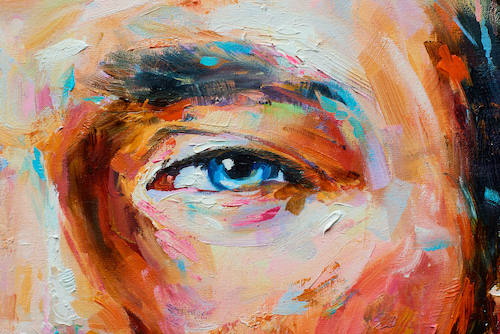Explore Old and Classic Oil Paintings for Sale Online
Discovering All Concerning Oil Paints: An Overview to Recognizing Their Appeal and Worth
Oil paintings have mesmerized audiences for centuries, offering a glimpse into the creative mastery of various periods. Their abundant history is linked with ingenious methods and profound psychological expression. Understanding the materials and methods behind these art work can improve recognition. Furthermore, the market for oil paints offers chances for financiers and collectors alike. As one discovers this interesting world, the inquiry develops: what makes an oil painting absolutely useful?
The History of Oil Painting: A Trip With Time
Oil painting has origins that date back to ancient times, it absolutely thrived throughout the Renaissance, when artists discovered its flexibility and rich color potential. Early examples can be traced to the 7th century, with methods progressing significantly across cultures. The tool ended up being noticeable in Northern Europe in the 15th century, especially via the jobs of artists like Jan van Eyck, who spearheaded its usage for detailed realism and vivid shades. This duration marked a departure from tempera paints, enabling greater depth and structure. As oil paint spread, it affected numerous artists, bring about masterpieces by prominent numbers such as Leonardo da Vinci and Rembrandt. The tool's tradition proceeds, forming the art globe well right into modern times.
Recognizing Oil Paints: Materials and Techniques
As musicians discover the globe of oil paints, they run into a diverse variety of products and strategies that define this medium. The main elements of oil paint consist of pigments, which give shade, and drying out oils, such as linseed, that bind the pigments and assist in application. Numerous additives can customize the paint's texture and drying out time, enhancing adaptability. Strategies like glazing, where clear layers are constructed up, and impasto, which involves using thick paint, permit different visual results. In addition, the usage of brushes, palette blades, and also fingers can produce one-of-a-kind textures and finishes. Recognizing these techniques and materials enables artists to totally share their creative thinking and attain the wanted influence in their art work.
The Function of Shade in Oil Paintings
Shade plays a pivotal duty in oil paintings, influencing both aesthetic charm and emotional resonance. Recognizing color concept fundamentals, consisting of the relationships in between tones, can boost a musician's capability to convey mood and ambience. Furthermore, mastering shade mixing techniques enables higher deepness and splendor in a painting's scheme.

Color Theory Fundamentals
Comprehending color concept is crucial for musicians collaborating with oil paints, as it develops the foundation for creating visually interesting and unified structures. Shade concept encompasses the research of exactly how colors engage, the color wheel, and the partnerships between key, second, and tertiary colors. Musicians make use of complementary colors to improve contrasts and create prime focus, while analogous shades promote unity and cohesiveness within a piece. Furthermore, the principles of cool and warm shades influence the assumption of depth and room in a paint. Realizing these concepts allows musicians to control shade properly, assisting the viewer's eye and communicating their desired message. Mastery of shade theory inevitably enhances an artist's capability to convey feelings and ideas through their job.
Emotional Effect of Shade
The emotional impact of color in oil paints plays an important duty in how visitors perceive and attach with art work. Colors evoke particular sensations and state of minds, influencing the customer's psychological state. Cozy shades like oranges and reds can develop a sense of warmth and energy, while great tones such as blues and environment-friendlies often evoke calmness or self-questioning. Artists purposefully choose color palettes to enhance narrative elements, directing the audience's emotional journey. The saturation and contrast of colors even more enhance these effects, attracting focus and developing focus. Inevitably, the interaction of colors in oil paintings not only boosts their visual charm however likewise functions as a powerful medium for emotional expression, enhancing the customer's experience and analysis.
Shade Combining Techniques
While several aspects of oil painting contribute to the total structure, grasping color blending methods is crucial for attaining preferred effects and deepness. Shade mixing can be come close to through different methods, including the additive and subtractive processes. Additive blending entails integrating colors of light, while subtractive mixing relies upon pigments, where colors mix to create new tones. Musicians commonly make use of a restricted combination to create harmonious jobs, understanding the partnerships in between key, secondary, and tertiary colors. Strategies such as glazing and scumbling even more enhance deepness and luminosity. By masterfully mixing shades, an artist can stimulate emotions, create focal factors, and accomplish a feeling of realism, inevitably raising the painting's psychological and aesthetic influence.
Famous Oil Painters and Their Iconic Functions

Famous for their proficiency of shade and technique, oil painters get more info have produced several of one of the most celebrated artworks in background. Prominent artists like Vincent van Gogh astounded audiences with his stirring brushwork in "Starry Evening," while Claude Monet's "Impact, Sunrise" laid the groundwork for Impressionism. Leonardo da Vinci's "Mona Lisa" remains an enduring symbol of imaginative wizard, showcasing his ability in recording human expression. At the same time, Rembrandt's "The Evening Watch" highlights his cutting-edge use light and darkness. Various other notable figures include Pablo Picasso, who reinvented contemporary art with his strong testing in works like "Les Demoiselles d'Avignon," and Georgia O'Keeffe, whose dynamic depictions of landscapes and blossoms aided specify American innovation. Each artist's special design contributed considerably to the oil painting landscape.
How to Evaluate the Top Quality of an Oil Paint
Examining the high quality of an oil painting involves a cautious evaluation of craftsmanship techniques, along with an evaluation of shade and composition. Observing brushwork, layering, and the application of paint can expose the artist's ability level. Additionally, the interplay of shades and the general arrangement of components add considerably to the paint's aesthetic worth.
Examining Craftsmanship Techniques
A thorough assessment of workmanship methods is crucial for determining the top quality of an oil paint. Critics ought to first examine the application of paint; thick, distinctive brushstrokes might suggest a skilled hand, while overly consistent applications might indicate a lack of deepness. oil paintings for sale. The layering method is also vital; the visibility of glazes and varied density can enhance brightness and complexity. Furthermore, the top quality of the materials made use of, such as the canvas and pigments, plays a significant duty in resilience and overall visual. Focus to detail in aspects like edges and changes in between colors reflects the musician's commitment to their craft. Ultimately, these strategies add to the painting's emotional effect and market price, functioning as indications of the musician's ability and intent
Analyzing Shade and Make-up
While examining the top quality of an oil painting, one have to concentrate on the interaction of shade and make-up, as these components are fundamental to the art work's overall effect. Shade options can stimulate feelings and establish mood; as a result, the musician's scheme need to be analyzed for harmony and contrast. A well-balanced structure directs the visitor's eye and produces a sense of unity. Artists usually utilize methods like the guideline of thirds or leading lines to improve visual rate of interest. Furthermore, making use of light and shadow can add depth, boosting the three-dimensionality of the paint. Ultimately, an effective oil painting marries color and composition, involving the visitor and welcoming a deeper recognition of the artist's vision and method.
Caring for and Preserving Oil Paintings
Proper treatment and conservation of oil paints is crucial for keeping their honesty and durability. To secure these artworks, it is vital to display them far from straight sunlight, which can cause fading and staining. Keeping a secure setting with regulated temperature level and moisture more help in stopping damage. Cleaning should be done delicately making use of a soft, completely dry fabric, preventing any type of severe chemicals that might harm the paint or varnish. Normal examinations for indicators of damage, such as flaking or breaking, are advisable. When saving or transporting oil paintings, appropriate cushioning and framing are essential to stay clear of physical damage. Eventually, diligent care adds to the visual allure and worth of oil paintings with time.
The Marketplace for Oil Paintings: Collecting and Spending
Understanding the market characteristics for oil paintings is crucial for enthusiasts and capitalists alike. The value of these art work is affected by different factors, consisting of the artist's reputation, historic importance, and current trends. Collectors typically look for pieces that reverberate personally while thinking about prospective appreciation in worth. Galleries and public auctions work as key venues for buying and marketing, with prices fluctuating based upon need and rarity. Investing in oil paints requires study into the marketplace, as well as an understanding of authenticity and provenance. Additionally, emerging artists might provide chances for substantial returns, while established names can command high prices. On the whole, a critical approach to gathering can produce both aesthetic enjoyment and monetary benefits.

Frequently Asked Concerns
What Are the Ecological Impacts of Oil Painting Materials?
The ecological influences of oil paint materials include the release of unstable natural substances (VOCs), harmful waste generation, and resource removal for pigments. These elements add to contamination and eco-friendly destruction, raising concerns amongst environmentally mindful artists and consumers.
Just How Do Different Canvases Affect Oil Painting Outcomes?
Various canvases affect oil paint results considerably. Texture, surface, and absorbency quality can alter paint application, drying times, and color vibrancy. Artists usually pick details canvases to attain preferred effects and enhance their artistic expression.
Can Oil Paintings Be Restored if Harmed?
Oil paints can without a doubt be recovered if harmed. Expert conservators make use of numerous techniques to repair rips, tidy surface areas, and address staining, making certain that the art work maintains its original beauty and worth for future generations.
What Are the Indications of an Original Oil Paint?
The indicators of an initial oil painting consist of noticeable brush strokes, structure variants, and an irregular canvas weave (oil paintings for sale). Furthermore, authenticity may be confirmed via provenance, signatures, and the presence of a varnish layer one-of-a-kind to oil tools
Exactly How Has Innovation Influenced Modern Oil Painting Techniques?
Modern technology has actually substantially affected contemporary oil painting methods by introducing electronic devices for planning, boosted materials for appearance and long life, and on the internet systems for offering and sharing art, thereby broadening artists' imaginative possibilities and audience get to. Oil painting has origins that date back to ancient times, it absolutely prospered throughout the Renaissance, when musicians discovered its convenience and rich shade potential. The emotional influence of color in oil paintings plays an important role in exactly how visitors view and attach with art work. While numerous facets of oil paint add to the overall composition, understanding color mixing strategies is necessary for accomplishing desired effects and deepness. Examining the quality of an oil paint includes a careful analysis of workmanship techniques, as well as an evaluation of color and make-up. While examining the quality of an oil paint, one should focus on the interaction of color and make-up, as these aspects are fundamental to the art work's overall influence.